eCommerce Copywriting Tips to Boost Your Sales
Learn effective eCommerce copywriting techniques to enhance your content and boost visitor conversions.
Originally Published at: https://wpswings.com/blog/ecommerce-copywriting/
eCommerce copywriting is an essential part of any online business. It is the outermost layer of your business system that builds your first impression among customers.
Copywriting for eCommerce serves as a hook that fits into customers’ eyes.
In the online space, you are not physically present to convince the world why they should buy your products, and so you need a great eCommerce product copy.
Now, there is plenty of information floating around on how to write the best eCommerce copy that makes your readers loosen their purse strings or compel them to perform the desired call to action.
Some people would say that God is in the details. Therefore, you must write highly elaborate pieces of content. While others advise being concise and crisp to make your content more consumable.
However, drawing these rigid lines around how to copyright is counterintuitive.
eCommerce copywriting is multi-dimensional. It is both creative and analytical in nature. You need to find a balance between both elements according to your business needs.
While the dexterity of an eCommerce copywriter isn’t defined by rules set in stone, there are some basics that they should keep in mind.
In this article, I’ll discuss the best eCommerce copywriting practices, copywriting benefits, and types and answer your questions regarding the same.
What is eCommerce Copywriting?
In simplest terms, eCommerce Copywriting is the content creation for online stores. Its main objective is to persuade customers to buy your products and services.
Despite sales being the end goal, it is not obligatory to write sales content. Rather, a well-prepared eCommerce copy educates and informs the customers about the utility and functionality of your product and adds value to their lives.
To write a copy that sells, you need to effectively communicate your brand’s merits through your content, offer value beyond the product, and curate content according to the buyer’s psychological makeup.
The written content includes product descriptions, articles, landing pages, documentation, ad copies, headlines, etc.
Essentially all areas where sales can come from require eCommerce copywriting.
As I remarked earlier, copywriting extends to various sectors within the eCommerce space. Website, B2B, B2C, SEO, Direct Response, and advertisement copywriting are some of the different types of eCommerce copywriting. I will discuss these in more detail.
Now, let’s learn the best practices for eCommerce copywriting.
eCommerce Copywriting Tips
Copywriting for eCommerce is an artistic work with the scientific method. It requires strong creative intelligence, psychological understanding, and communication skills.
Some experts would define copywriting as the method to sell without selling. It is the process of attracting, engaging, and gratifying customers. You should follow these best eCommerce copywriting practices to create content:
a) Know Your Niche
“To know thyself is the beginning of wisdom.” – Socrates
A niche represents the segmented category under which your products or services come. Before copywriting for your eCommerce business, figure out what you are selling. Also, determine its scope, market size, and potential customers.
Self-awareness helps an eCommerce copywriter create content that has a sense of completeness, which is one of the elements of effective communication.
Your prepared copy must make complete sense to the readers. This is especially important if you are writing legal, technical, or commercial content of serious nature.
Having complete knowledge of your niche business, its products, and competitors will be extremely helpful during sales copywriting.
b) Audience Research
Okay, you know your business like the back of your hand. But do you know your audience?
Audience research is an integral part of copywriting.
Using advanced analytical tools, we can accurately create the persona of the ideal content consumer and organize our content accordingly.
It includes collecting demographic information and tracking user behavior, challenges & interests, and general motivations.
On a much deeper level, all available data points are collected and organized to draw out the semi-realistic personality of the end-user. Even the vapid details we hardly pay any heed to are extensively recorded.
You can create the ideal customer personas and write your product copy to persuade them.
For example, DollarShaveClub.com has a minimalistic design. Their website copy consists of simple words, relatable content, and personalization. They also have a blog where they post articles mostly related to their niche, which is men’s grooming.
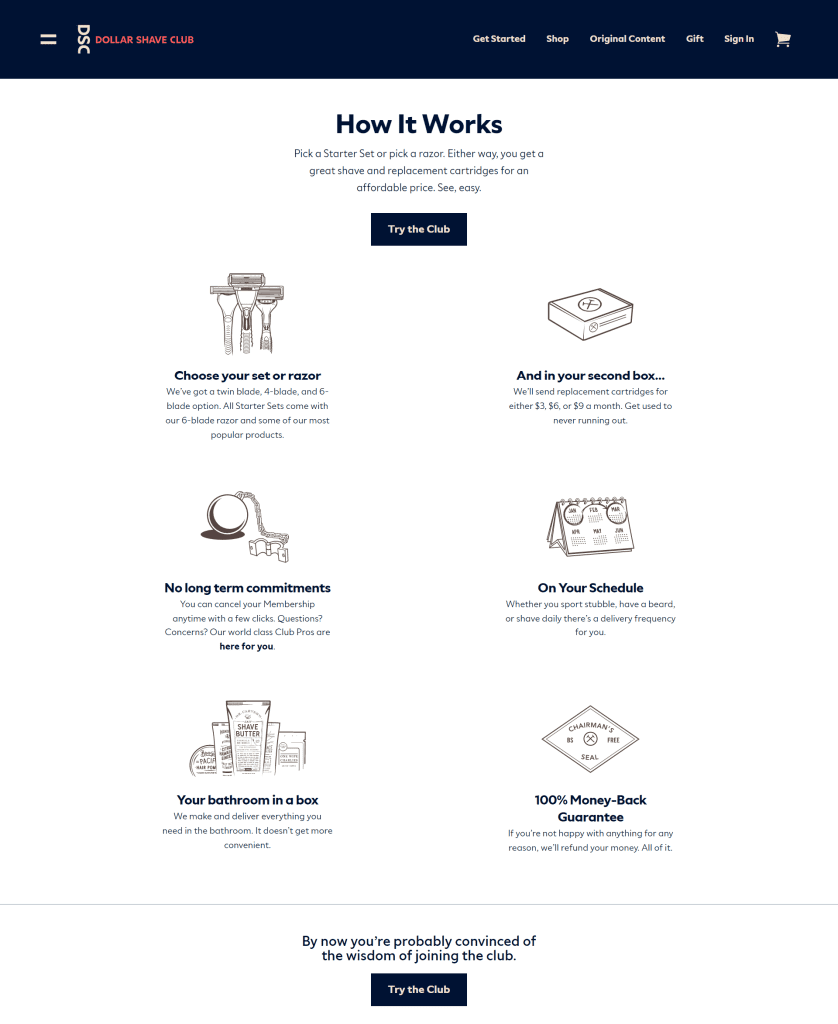
The eCommerce copywriting strategy helps them cater to their primary user base — men between the ages of 18 to 29 years.
c) Attractive Headlines
A great copy needs a greater headline. It is one of the most important aspects of copywriting for eCommerce websites.
The headline is the hook to catch readers’ attention. It is the first thing they notice before opening any article. More often than not, it might be the only thing they read.
Yes, you heard me correctly. 70% of people don’t read beyond the headline. In simpler words, they just read the headline and never consume the content.
You have to come up with a catchy headline that accurately reflects the subject matter of your article. It can even be used to create suspense and curiosity.
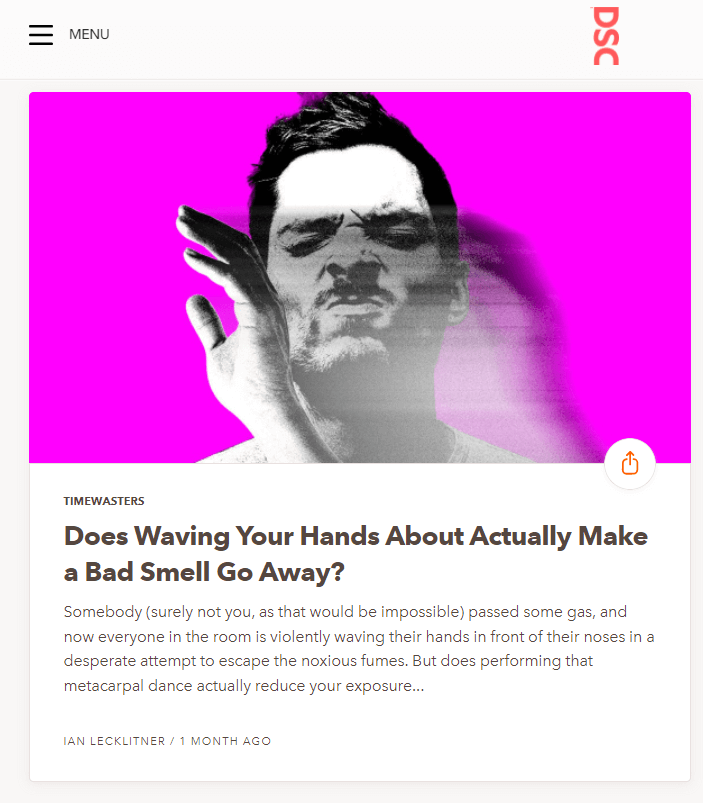
For example, this headline asks a question about something we have all been doing for ages i.e. waving our hands to make the bad smell go away. But does it work?
It makes you instantly curious to read the article. Such is the power of a great headline. It can dramatically increase your CTR and engagement rates and ensure that customers share your work.
d) Keep It Simple But Creative
Most people avoid reading, not because they don’t have time, but because they don’t understand complex content.
The easier your eCommerce Writing is to comprehend, the more conversion you can draw.
Content consumption demands the content be digestible. Otherwise, people will simply choose not to read the content.
The aim of eCommerce copywriting is to persuade the viewer, not dissuade them.
Initially, your creativity might take a few hits, but eventually, you’ll learn how to improve your readability and be creative at the same time.
When you are writing a product copy, you’ve to explain the utility, features, and different functions of your product in the simplest way possible.
Avoid using words that are hard to spell. You are making a sales pitch, not hosting a Spelling bee competition. Infusing humor or pop culture references in your eCommerce copy is fine though.
Also, you should minimize the use of abbreviations, jargon, complex definitions, etc.
Essentially you have to write a copy that even a middle schooler can understand. That’s what the Flesch reading ease score identifies as the best content.
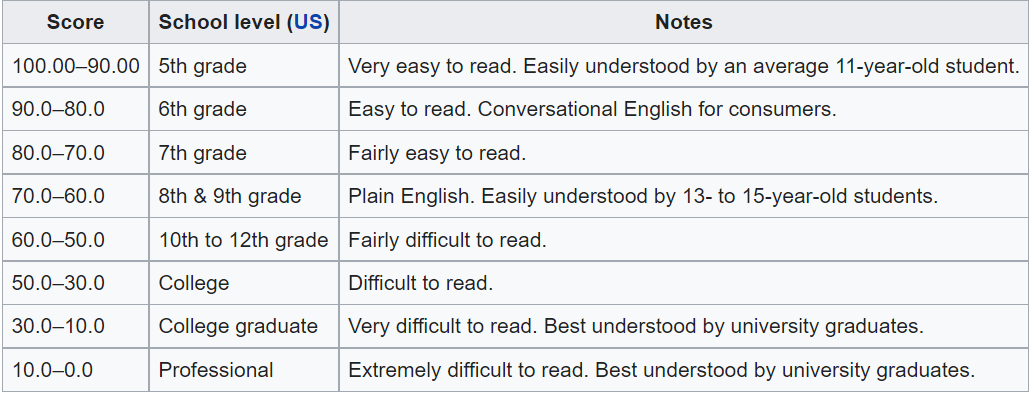
Bottom line: Your eCommerce copy should be simple enough to be understood by a middle school student.
e) Focus On Value Addition
This is the age of information. The abundance of knowledge on the internet gives people the power to thoroughly research the market before making the final purchase decision.
Customers are not merely looking for products, they want solutions to their problems. For many of us, learning before buying is an inseparable part of the shopping ritual.
Throughout the buying process, you need to provide value to your customers with your eCommerce copywriting to maximize the acquisition rate.
At the Awareness stage, people usually try to identify their problem or pain point. Your eCommerce copy at this point should help them to understand the nature and gravity of their problem.
At the Consideration stage, the potential customer (visitor) has successfully recognized their problems and is actively seeking an affordable solution. Now, you can offer all possible solutions, including yours. Draw comparisons with your competitors and show how you can do a better job.
Lastly, at the Decision stage, the visitor decides to purchase your product after reading through your product-based content and finding the value they need.
Value-added content increases conversion. It forms the basis of eCommerce copywriting — to sell without selling.
You can use blogs, ebooks, videos, podcasts, infographics, product guides, tutorials, white papers, webinars, free tools, etc., to add value to the lives of your customers.
f) The Power of Storytelling
Storytelling is a powerful tool in a copywriter’s arsenal. It builds the narrative, which establishes a sense of connectivity between you and your audience.
For example,
“I was in a locked room with a roach and a spider…”
“I am about to break the first rule of Fight Club”
“Should snoozers like you and me keep an alarm clock?”
All these opening lines instantly engage the readers and stir up some feelings. I’m sure you are especially intrigued or horrified after reading the first one.
Storytelling is deeply rooted in the human psyche. An eCommerce copywriter can use storytelling to build a narrative favorable for product promotion.
For example,
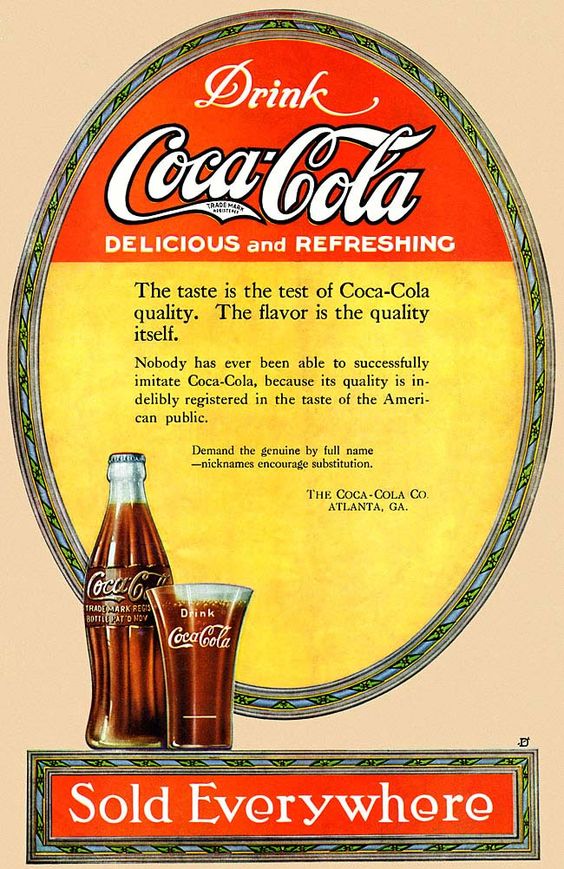
Here is a Coca-Cola ad in the 1919 issue of People’s Home Journal. In limited words, it conveys that the taste of original Coca-Cola is unique and can’t be replicated. It accomplishes two objectives: reinforcing their uniqueness and encouraging people to buy the original product.
g) Be Positive
At a time when COVID-19 is reemerging, if someone says the phrase ‘Be positive’ to you, it may result in tighter breathing and zero at the bone.
But in copywriting, try to almost always be positive.
Using positive framing while copywriting for eCommerce helps you sound more assertive and confident. People will listen to you and may even proceed to accept and act according to the message of your content.
For example,
Negative:*Stop being fooled by the marketing tools you’re using. Use our XYZ marketing tool, which will not waste your money and not slow down your growth.*
Positive:*Be a smart businessman by using genuine tools. Get the XYZ marketing tool that is cost-effective and unlocks your business growth.*
The second sentence sounds more positive and confident and asserts the optimum usability of the product.
Positive eCommerce copywriting also makes the sentences shorter. It is important because if you can convey a message in fewer words, then you should.
Here is another example,
Negative:*While copywriting for eCommerce, don’t use complex sentences.*
Positive:*Use simpler sentences while copywriting for eCommerce.*
Psychologically speaking, a positive framing builds a positive attitude toward problems. Instead of focusing on the negative, clearly state how your product can solve their problems. Convey an affirmative message to customers in a shorter way. And get your desired result.
h) Personalization
Personalization in eCommerce copywriting refers to the content creation to suit the requirements of the readers.
I’ve been personalizing this article by directly addressing ‘you’ my dear readers. This is a form of common personalization that you can incorporate into your work.
The biggest benefit of personalization is that readers feel special when they are addressed directly. The copy becomes much more engaging to them.
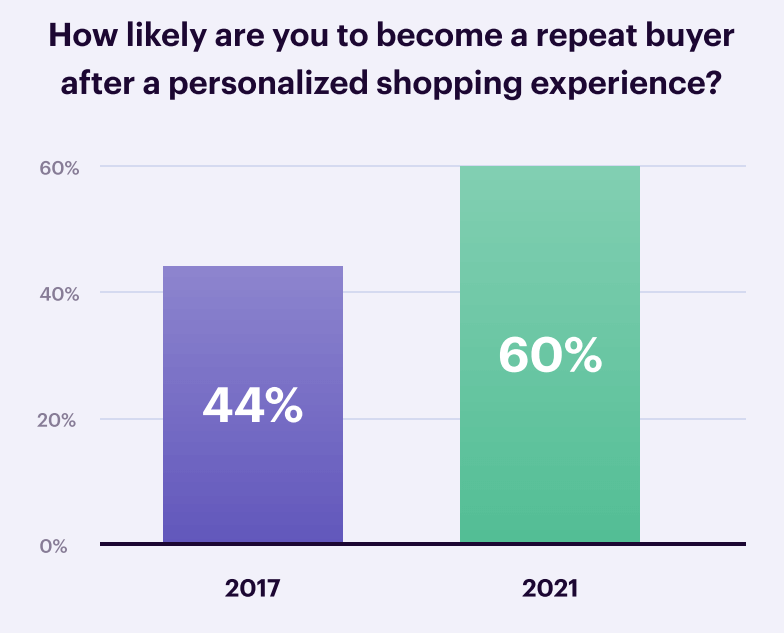
[Source: State of Personalization Report 2021]
Taking this to the next level, you can use geo-personalization on your website. It tracks the IP addresses of the visitors and welcomes them with a greeting that’s relevant to their region.
Email copywriting also requires personalizing your content. You can address the customers or leads using their names.
Reusing to directly address your users will make your content a bit detached and plain. So, to spice things up, try to interact with them using personalization.
i) Remember the Basics
You start from the button and then you go up. Most copywriters make the mistake of focusing their attention on writing advanced things and end up messing up minute details.
Grammar, sentence structure, punctuation marks, correct spelling, appropriate terms, etc., are all equally important.
Whatever language you are using, it is necessary to have absolute command over it.
Correcting the basics ensures that your content has clarity and complete sense. It makes your copy a beautiful read.
j) Be Unique
The last and perhaps the most defining tip for eCommerce copywriting is making a unique copy.
What many copywriters do is try to imitate the work of top players in the game, thinking that it would yield the same results for them.
But…
Reality is often disappointing. – Thanos.
Creating an original eCommerce copy requires consistent work and may take a while to perform, but it will build a strong brand identity.
Anyone can have their 15 minutes of fame. However, it takes the mightiest efforts to remain relevant for ages. So, channel your inner Sisyphus and play the long game.
Moreover, creating your content gives you the chance to develop a unique image in the eCommerce space.
Unique content makes your copywriting more memorable and adds to your authenticity.
So, these are the best eCommerce copywriting practices that you should follow while promoting your business.
Benefits of Good Copywriting
There are plenty of benefits of good copywriting. It’s a topic in itself and would require a separate article. However, I’m going to explain the most considerable benefits of good eCommerce copywriting.
So, let’s dive in.
1. Copywriting Improves Conversions
Words have a direct impact on our actions. Good eCommerce copywriting not only engages your customers but also encourages them to take action.
On an online store, copywriting is required for product pages, landing pages, blogs, product documentation, and everything else. From the initial stage to the last, written content leads the users through the sales funnel.
Thus, converting a visitor into a customer and achieving the core objective of eCommerce Copywriting.
2. Connects with Audiences
Dynamics are quite different in an online store. Customers don’t interact with you as they would in a retail store. So, it lacks the human touch.
That’s where good eCommerce copywriting shines. It adds the missing human touch to the website and makes the interaction meaningful. People yearn for connection, even while shopping.
If they feel that they are welcomed and respected then they are likely to purchase the product repeatedly from your online store. Repeat customers constitute a significant proportion of revenue.
This human touch increases engagement on-site and on social media as well. People feel that you care for them and trust you with their money. It essentially turns customers into promoters.
Build A Successful Customer Loyalty System for Ecommerce Store
3. Makes CTAs More Persuasive
Call to action (CTAs) work solely because of great copywriting. Engaging users is far easier than making them perform certain tasks.
The rate of conversion reflects the effectiveness of your content. Moreover, conversion doesn’t necessarily mean purchase. One can also define it as signing up, sharing, opening another webpage, etc.
Written content has the power to move users and compel them to complete a call to action.
However, visitors will only fulfill a call to action if they feel it benefits them. Other than that, they may comply out of loyalty or sheer cluelessness.
Copywriting for eCommerce CTAs should be creative, concise, and crisp.
For example, Dr. Squatch is a personal care brand for men that sells natural products.

At first, they address their primary customer base. Second, they remark that their products are made with natural ingredients. And lastly, a simple call to action button with an appealing offer.
4. Great Copywriting Ensures Great User Experience.
eCommerce user experience is defined as the users’ sentiment after interacting with your eCommerce site.
User experience depends upon several factors such as site speed, navigation, color scheme, font, product organization, etc.
Content is one of the main factors that define UX. And copywriting primarily deals with sales-oriented content.
As a copywriter, your job is not to entertain but to sell. However, entertainment increases engagement and increases the efficacy of your product copy.
The value beyond the product doesn’t necessarily have to come from offering freebies, infographics, etc., a finely crafted copy in itself is a joy to read.
Sometimes, customers are conflicted about choosing between two products if both have similar features and benefits. In such scenarios, a better UX plays a pivotal role in securing the deal.
Your written copy should satisfy the user’s curiosity, establish a sense of connection, and reinforce the benefits of using your product or service.
And that’s it. These are the main benefits of eCommerce copywriting.
Different Types of eCommerce Copywriting
Copywriting for eCommerce is the process of writing compelling content to market products and services, with sales being the ultimate goal.
It is advertorial in nature and is usually applied to writing product-based content. The promotional element is what sets copywriting apart from content writing.
Content writing includes every single piece of the written content of an eCommerce website. Whereas copywriting deals with sales-related content such as emails, product descriptions, landing pages, etc.
It can be broken down into the following sub-categories:
SEO Copywriting
Search engine optimization (SEO) copywriting is the process of applying a set of techniques to improve the organic search ranking of your content.
It includes integrating keywords into your copy and addressing the commonly searched topics to achieve higher visibility. You can use SEO copywriting to create titles, meta descriptions, ads, product pages, etc.
Social Media Copywriting
Social media is the ultimate tool to build brand image. In fact, 92% of marketers say that social media is important to their business.
Copywriting for social media is the process of creating content in a format suitable for popular social media platforms such as Twitter, Facebook, Instagram, etc., to market your product and services.
Brands mostly use social media to informally interact with their customers and improve their engagement rates. It can be a great medium to gain new customers as well.
For example, we promote our WordPress/WooCommerce plugins on Twitter using infographics with catchy captions.
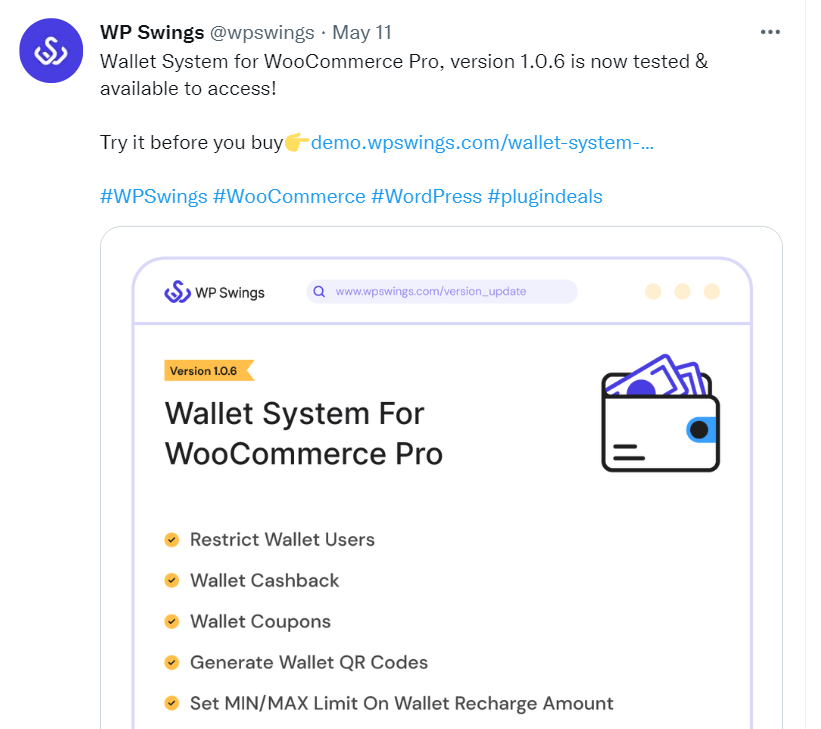
This social media copywriting includes writing posts with attractive captions, giving shoutouts to customers, responding to comments, posting updates regarding products, and so on. The possibilities are endless here. Most social sites have billions of active users that can be converted into loyal followers.
23 Tips For Building A Brand Through Social Media Platforms
B2B Copywriting
B2B stands for business to business. The aim of B2B copywriting is to market your products or services to other businesses. Unlike individuals, companies have a group of individuals who carefully make purchase decisions. As a result, impulse buying is hardly ever noticed in the B2B sector.
Considering the complexities of the purchase process, you have to go the extra mile and write extremely convincing content to convert your clients.
B2B buyers do far deeper market research before purchasing anything. You can nurture these buyers using blogs, ebooks, case studies, white papers, etc.
Video Copywriting
Visual copywriting is rarely discussed but it is one of the popular forms of copywriting we have today. Videos play a crucial role in marketing on YouTube, online stores, or social media platforms.
When it comes to promotional content, video is the go-to option for most businesses. Mainly because YouTube is the second-largest search engine. People love watching videos again about the products they are considering purchasing or have already bought.
The copywriting for videos includes scriptwriting, captions, video descriptions, etc. Promotional content in the video format is easily understood by customers and has a higher chance of going viral.
How YouTube Videos Can Aid Your WordPress Strategy?
Advertorial Copywriting
Organic search rankings aren’t enough sometimes. So, companies run a fair bit of ads to become more visible and create an impression in the minds of potential customers.
Copywriting for advertising requires the copywriter to craft all written parts of the advertisement. eCommerce websites run ads on YouTube, social media, Google, etc.
Your advertisement copy must offer a solution, include emotional triggers, and use statistics in support of your claims. Make each word count because running ads costs a fortune. It is a high-risk high-reward move.
So, these were the popular forms of copywriting. I have already discussed the other copywriting types such as B2C, technical, eCommerce, sales, direct response, etc., throughout the article.
On a Final Note
eCommerce copywriting is the process of creating content that promotes products and services. It drives user engagement through value addition and ensures optimal conversions.
In this article, I have discussed the best eCommerce copywriting practices and the benefits and types of copywriting.
Using the methods mentioned above, you can organize and develop your copywriting capabilities and boost your conversion rates.
To learn more about eCommerce and WordPress, please check out more articles.
